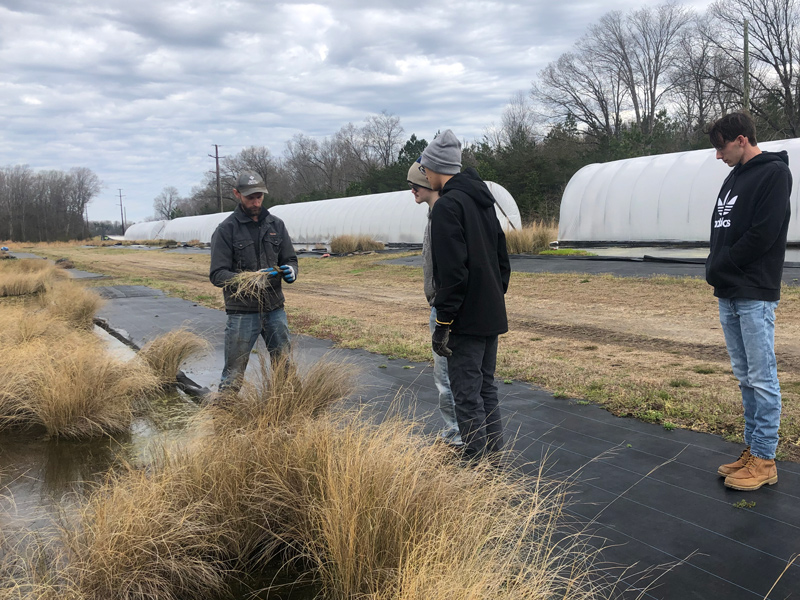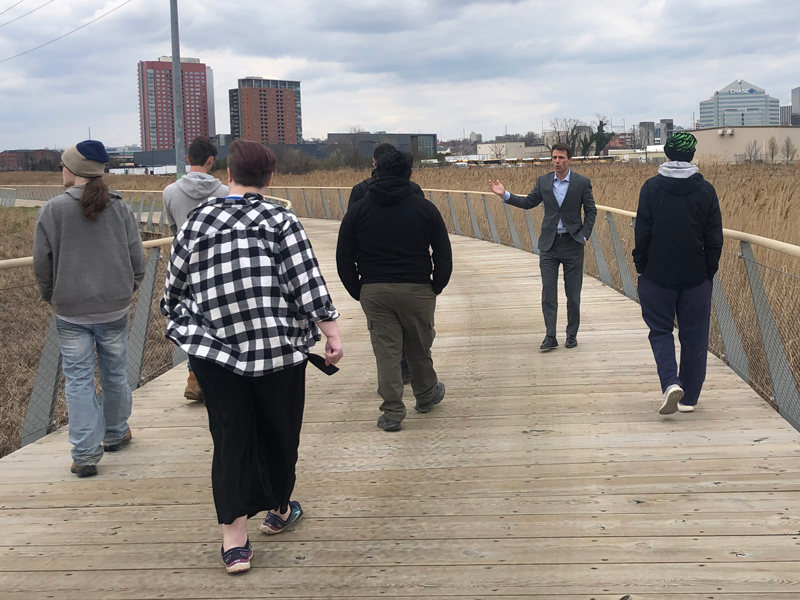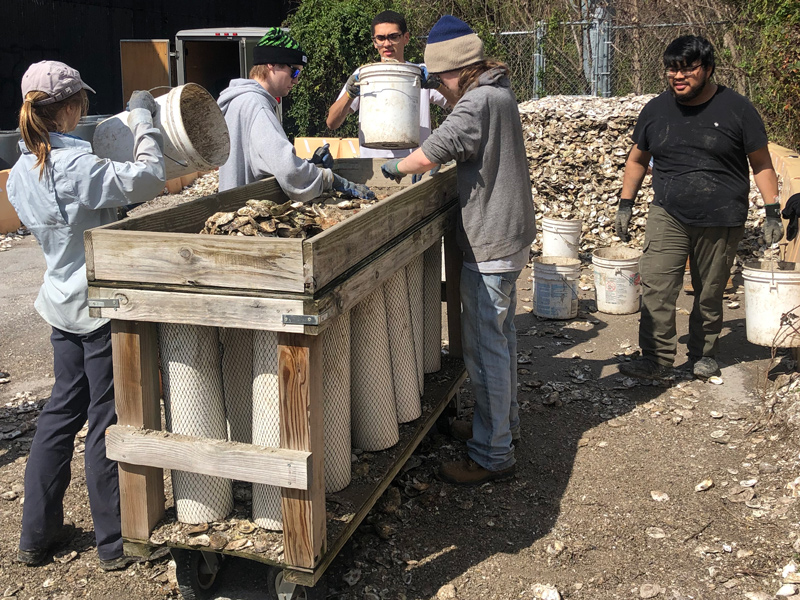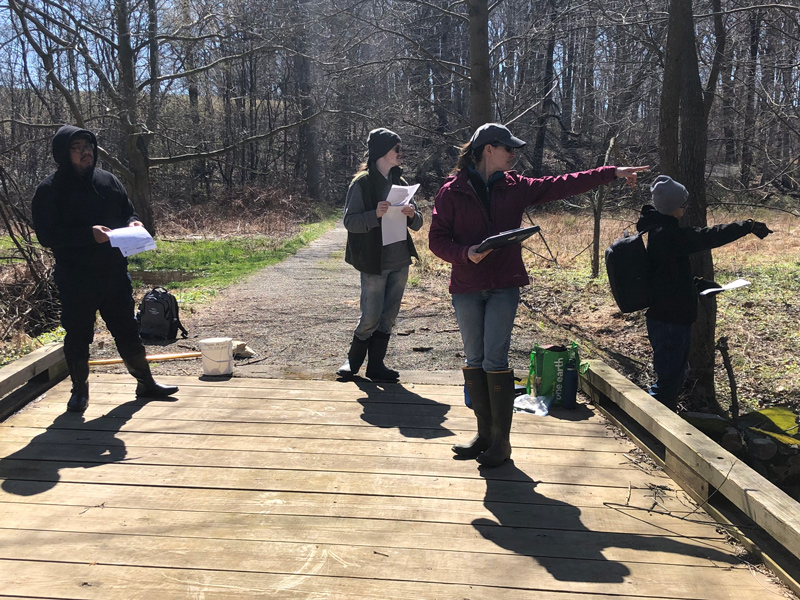


Green infrastructure
Photos courtesy of Emma Ruggiero June 13, 2022
Delaware Sea Grant partners with Delaware Technical Community College to give students hands-on experience
As evidenced by the spring storms that brought 70 mile per hour winds, erosion, high tides, and flooding and caused beach closures up and down the Delaware coast, innovative ways of dealing with, planning for and mitigating the impacts of storms are needed for the First State.
One option for helping to improve Delaware’s vulnerability to these challenges is to implement what’s known as green infrastructure.
Broadly speaking, green infrastructure is a nature-based approach to address environmental challenges by using natural materials, such as plants and soils, and natural processes, such as infiltration and absorption. This is in contrast to what is known as grey infrastructure, man-made projects that use unnatural materials like concrete and steel and rely on unnatural processes such as impervious surface water runoff and sewer systems.
Students from Delaware Technical Community College learned firsthand during the spring semester about how to implement, design, construct and maintain green infrastructure projects, as well gain an overview of environmental resilience challenges in Delaware, as part of the Delaware Sea Grant (DESG) Green Infrastructure Internship Program.
The internship was led by Emma Ruggiero, DESG’s workforce development coordinator and a doctoral student in the University of Delaware’s Department of Plant and Soil Sciences, who said that green infrastructure could benefit Delaware in several different ways.
“Green infrastructure is meant to not only improve the environment, but also improve conditions for communities in Delaware,” said Ruggiero. “Impacts related to coastal hazards are especially important for the state to start to manage and because we know that green infrastructure can have a positive impact on water quality and water quantity, there is an opportunity for Delaware to utilize green infrastructure. The problem is there’s really not the workforce to perform the design, the installation or the management.”

To help educate this potential workforce, DESG taught the interns in a virtual classroom setting and took them around the state to look at examples of green infrastructure sites. The students who participate in the program are compensated for their work and travel.
In the colder days at the beginning of the semester, the class was mostly virtual and students received an overview of green infrastructure and coastal hazards. They learned about the design and installation of green infrastructure projects such as living shorelines, rain gardens and riparian buffers.
Once the weather warmed up, the students headed out to work with environmental partners throughout the state including:
Forest View Nursery;
Environmental Concern;
The Delaware Botanic Gardens;
The Partnership for the Delaware Estuary;
The City of Wilmington at South Wilmington Wetlands Park;
Delmarva Native Plants;
The Delaware Nature Society at the Coverdale Farm Preserve; and
The Nanticoke Watershed Alliance
The projects they worked on and learned about ranged from oyster shell recycling to native plants to sustainable farming.

Ruggiero said that, as most of the students involved in the program have an engineering or construction background, they seemed particularly engaged with the projects going on at the Delaware Botanic Gardens.
“The gardens were such an interesting example of how you can marry the construction with greening,” said Ruggiero. “They were interested in the living shoreline and how a portion of that is nature-based, using natural material on the site, but there’s also a portion of it that uses harder materials, like rocks, to protect from more of the harsh waves that are impacting the shoreline.”
Vincent LaPosta, who is planning on transferring to UD to study civil engineering after finishing his associate degree, said he was drawn to the green infrastructure internship after learning in his hydrology and drafting class about best management practices, which are designed to guide activities that promote stewardship of the environment. He was not familiar with the term green infrastructure until he participated in the internship.
“I now know that green infrastructure is basically a nature-based approach to some engineering solutions,” said LaPosta. “It can help with flood control and targets ecological issues like water quality. Also, there are green infrastructure projects that try to support pollinators and try to re-invigorate natural structures to provide natural benefits.”

LaPosta enjoyed the hands-on experience he gained with the Nanticoke River Alliance, where the students pulled invasive plants from the site and also planted native species. Because of the connections he made during that field experience, LaPosta recently accepted a position as a Green Infrastructure Intern at the Nanticoke River Alliance.
Internship students also got to conduct mock interviews and learn how to successfully construct cover letters and resumes.
Jordan Clark, a civil engineering major at Delaware Technical Community College who is going to graduate with an associate degree and then transfer to UD to study civil engineering, said it was beneficial to get feedback on how he performed during his mock job interview so he can practice and improve.
He also said it was interesting to learn about water sampling and water quality, and that the most beneficial aspect for him was the design work, which complemented his studies in civil engineering.
“We learned about what plants work best in certain areas, and I think that’s important for civil engineers,” said Clark. “It ensures that plant life is balanced and that the environment is healthy.”
With a good amount of engineering students involved in the class this year, Ruggiero said it was great to see how the students blended their engineering expertise with environmentalism.
“I think this information is relevant to a lot of the engineering degrees and opportunities,” said Ruggiero. “If they’re building, they’ll understand what impact that construction will have on the environment and maybe advocate for more greening surrounding what new development projects they are working on.”
Contact Us
Have a UDaily story idea?
Contact us at ocm@udel.edu
Members of the press
Contact us at 302-831-NEWS or visit the Media Relations website

